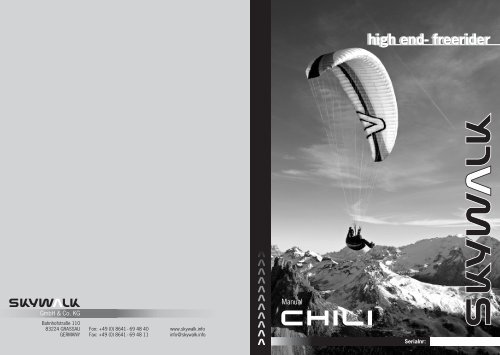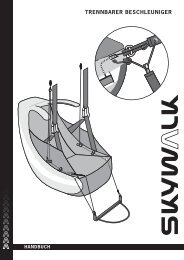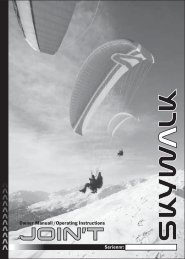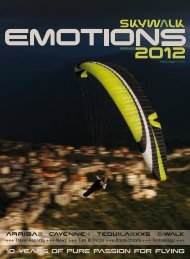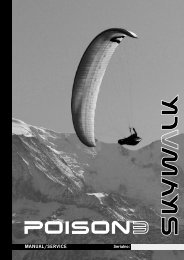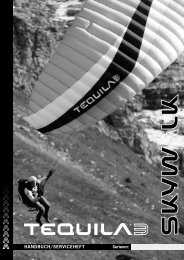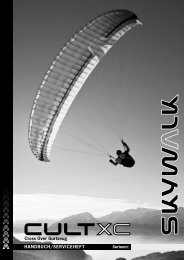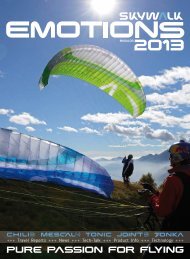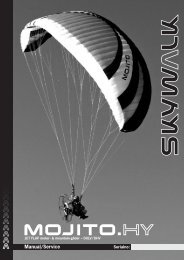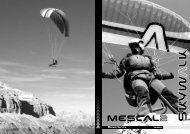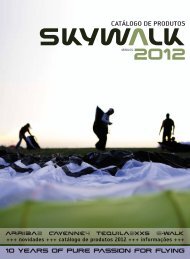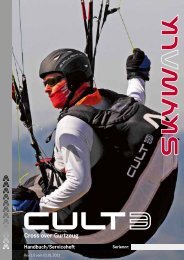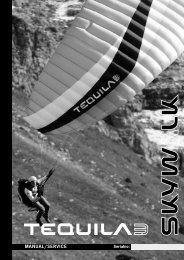chili_e - Skywalk
chili_e - Skywalk
chili_e - Skywalk
You also want an ePaper? Increase the reach of your titles
YUMPU automatically turns print PDFs into web optimized ePapers that Google loves.
high end- freerider<br />
Manual<br />
GmbH & Co. KG<br />
Bahnhofstraße 110<br />
83224 GRASSAU<br />
GERMANY<br />
Fon: +49 (0) 8641 - 69 48 40<br />
Fax: +49 (0) 8641 - 69 48 11<br />
www.skywalk.info<br />
info@skywalk.info<br />
Serialnr:
INDEX<br />
1<br />
2<br />
3<br />
4<br />
5<br />
6<br />
7<br />
8<br />
9<br />
10<br />
11<br />
12<br />
13<br />
14<br />
15<br />
16<br />
17<br />
Congratulation 39<br />
Description 40<br />
Line System 41<br />
Technical Data 43<br />
Acceleration System 44<br />
Harness 45<br />
Flight Techniques and Characteristics 46<br />
Descent Techniques 52<br />
Extreme Flight Manoeuvres 55<br />
Materials 59<br />
Maintenance 60<br />
2-Year-Check 63<br />
Certification 64<br />
Conclusion 65<br />
Line Plan 66<br />
Test Protocol 67<br />
Riser 70<br />
CONGRATULATIONS<br />
We would like to congratulate you with the purchase of your new CHILI, and thank you<br />
for the confidence that you have put into us.<br />
We are sure that you will enjoy every flying minute with your new<br />
skywalk CHILI.<br />
To ensure that you will feel good with your glider from the very start, we advise you<br />
to read this manual carefully. This way, you will get to know your skywalk CHILI quickly<br />
and thoroughly. This manual will give you tips to fly more securely, so that you will<br />
have fun with your new CHILI for a long time.<br />
We are always open to remarks, questions and comments. Call us or send an e-mail<br />
or fax.<br />
The skywalk team is available for information at any time.<br />
Your skywalk Team<br />
38<br />
39
DESCRIPTION<br />
In the last few years a remarkable modification in the market for DHV 1-2 gliders<br />
happened. Simple products, as well usable for students share the category with high<br />
performance, challenging products. The CHILI is clearly situated at the very upper end<br />
of DHV 1-2 class. The performance is used to be even better than some of the DHV<br />
2 wings and the handling is as well very direct. For that reason the CHILI is not<br />
recommended to beginners or for schooling even when the behaviour of this wing in<br />
extreme situations fits to the DHV 1-2 category.<br />
In the CHILI one finds the impassionate work, diligence in every little detail and new<br />
instruments of development.<br />
Maximum of performance, safety, stability, handling and joy of flight are the characteristics<br />
of this wing.<br />
The chosen profile possesses an excellent stability, also at higher speeds. The CHILI<br />
performs very well throughout a wide speed range, yet the manoeuvrability in thermals<br />
is very good. The gliders remain very manageable, even in turbulence, and weak<br />
thermals are converted to altitude effortlessly thanks to JETFLAP Technology.<br />
In all cells diagonal and parallel bands even the load.<br />
With so-called ballooning, that is the inflation of the cells in the computer model, we<br />
were able to create a very homogeneous canopy.<br />
The high surface quality of the wing is a direct consequence of this ballooning technique<br />
and this among other things generates the high performance.<br />
An optimized suspension system with load dependent line diameters takes care of low<br />
drag with very good wing support.<br />
In the leading edge area of the upper wing, the CHILI employs Porcher Marine cloth<br />
9092E85 which features outstanding ageing resistance. This, together with the wellknown<br />
good craftsmanship, guarantees excellent longevity and value retention.<br />
We wish you beautiful, long and successful flights.<br />
Your gear is waiting.<br />
LINE SYSTEM<br />
To achieve an optimal line system, much fiddling and calculating was done.<br />
In cooperation with line manufacturer LIROS we chose the optimum mix of materials<br />
for the CHILI.<br />
The main focus was on drag, line control and effectivity of the speed system.<br />
Generous dimensioning of the lines provides very high load reserves.<br />
The meaningful combination of Tecnora and Dyneema lines is robust yet generates<br />
little drag.<br />
Very good restorability, even after high strains, as well as little stretch are also the<br />
consequence of the applied line mix.<br />
The skywalk CHILI has 3 A-, 3 B- and 1 stabiliser line, 3 C- as well as 2 D-main lines.<br />
Secondary lines: Top lines (top of the line system under the canopy) and mainlines.<br />
These unite 3 top lines and lead to the carabiner at the riser (maillon rapide which<br />
connects the main lines with the riser).<br />
The stabiliser lines connect to the top stabiliser lines with the carabiner.<br />
The brake lines are none carrying and lead from the back of the canopy (=trailing<br />
edge) over the main brake line through the pulley on the D-riser to the brake handle.<br />
There is a mark on the main brake line indicating the position of the Handle attachment.<br />
This adjustment mustn’t be altered in order to provide enough brake feedback for<br />
landing and in extreme flight situations yet enough slack not to continuously brake<br />
the glider in normal flight.<br />
For better identification, the A-lines, the stabiliser lines and the A-risers are coloured<br />
red. The B-lines, main brake lines and the brake lines are coloured yellow and all the<br />
other lines are blue.<br />
The carabiners at the risers are triangular, a rubber ring prevents the lines from<br />
shifting.<br />
Your skywalk Team<br />
40 41
TECHNICAL DATA<br />
The CHILI has five risers. The two inner A-mainlines lead to the first A-riser, the outer<br />
A-line leads to the second A-riser, B-lines are attached to the B-riser, C-lines and the<br />
Stabilo is attached to the C-riser and finally the D-lines lead to the D-riser.<br />
For line arrangements, look up line plan, page 29<br />
IMPORTANT SAFETY WARNING:<br />
FLYING A PARAGLIDER REQUIRE A MAXIMUM CAUTION AT ALL<br />
TIMES. BE AWARE THAT FLYING YOUR PARAGLIDER IS AT YOUR<br />
OWN RISK. AS A PILOT YOU HAVE TO GUARANTEE THE FLYING<br />
CAPABILITY OF YOUR PARAGLIDER BEFORE EVERY SINGLE FLIGHT.<br />
Don’t use your skywalk CHILI:<br />
Outside the certified take-off weight<br />
With any engine, except you have a license from the BHPA / USHPGA<br />
In rainy, snowy and extremely turbulent weather conditions or high winds<br />
In fog or clouds<br />
With insufficient experience or training<br />
Typ XS S M L<br />
Number of cells 51 51 51 51<br />
Area (m2) 23,2 25,2 27,4 30,3<br />
Wing-span (m) 11,06 11,53 12,02 12,65<br />
Aspect ratio 5,28 5,28 5,28 5,28<br />
Area, projected (m2) 19,15 21,8 23,7 26,25<br />
Wing-span, projected (m) 8,67 9,26 9,65 10,16<br />
Aspect ratio, projected 3,93 3,93 3,93 3,93<br />
Average Linelength (cm) 693 723 754 793<br />
Line diameter (mm) 1,2/1,8 1,2/1,8 1,2/1,8 1,2/1,8<br />
Cord max (cm) 259 270 282 297<br />
Cord min (cm) 43 45 47 49<br />
Canopy weight (kg) 5,2 5,6 6,1 6,8<br />
Certif. take-off weight*(kg) 55-80 75-95 90-110 105-130<br />
* Pilot + ca. 17 kg equipment<br />
The CHILI suits not for students, its handling exceeds the students<br />
abilities for sure!<br />
Every pilot is responsible for his own safety and will have to ensure that his aircraft<br />
(paraglider) has been checked and serviced for its airworthiness before flying.<br />
You can only fly your skywalk CHILI with a valid flying license and in accordance with<br />
local rules and regulations.<br />
During its production your skywalk CHILI has passed several thorough quality control<br />
checks. More spot checks were performed before its despatch.<br />
CAUTION:<br />
THE TYPE-SHEET IS PRINTED ONTO THE INSIDE OF THE<br />
STABILO.DATE AND NAME OF THE PILOT OF THE FIRST FLIGHT<br />
HAVE TO BE ENTERED IN PRINTING AT THE WINGTIP<br />
42 43
ACCELERATION SYSTEM<br />
HARNESS<br />
The skywalk CHILI can be equipped with a foot operated Acceleration System.<br />
CAUTION:<br />
THE DHV RATING OF SOME GLIDER SIZES CAN CHANGE DURING<br />
THE USE OF THE ACCELERATION SYSTEM IN FLIGHT. TO<br />
DETERMINE WHICH SIZES ARE AFFECTED PLEASE CHECK THE<br />
TYPE SHEET.<br />
The acceleration system is influencing the A-, B- and C-risers. In the normal position<br />
all risers lengths are equal: 50.5 cm overall without shackles.<br />
The skywalk CHILI licensed for all certified harnesses of the GH type<br />
(harnesses without solid cross-bracing).<br />
Be aware that the level of suspension changes the relative braking distance.<br />
We recommend the skywalk harness CULT. It supports the direct handling of CHILI<br />
and increases joy in flying.<br />
CAUTION:<br />
FULLY CROSS-BRACED HARNESSES EFFECT THE HANDLING<br />
DRASTICALLY AND DO NOT LEAD TO HIGHER SAFETY!<br />
When fully applied, the accelerator is shortening the A-risers about 17 cm, the B-riser<br />
about 14 cm and the C-riser about 6.5 cm. The D-riser remains in its original length.<br />
That implicates that as well in accelerated flight the canopy remains in an optimum<br />
shape. Lengths for sizes XS and S please see riser sheet page 34<br />
Installing the accelerator equipment:<br />
Most commonly used harnesses have pulleys for the acceleration-system already<br />
attached.The acceleration line runs from the front through the pulleys at the harness<br />
to the top. They are tied to the ”Brummel-hooks” at the right length.<br />
With the right adjustment of the acceleration lines, the foot-bar can be reached easily<br />
with angled during flight. By straightening the legs, the whole acceleration range can<br />
be used.<br />
Prior to flying, the connection hooks of the foot-operated accelerator and<br />
the acceleration system have to be connected to each other (Brummel-hooks).<br />
Check that the acceleration line runs freely.<br />
Function:<br />
By using the foot-operated accelerator the<br />
pilot reduces the force via a pulley-system<br />
by half and shortens the A-, B- and C-risers.<br />
44 45
FLIGHT TECHNIQUES AND CHARACTERISTICS<br />
Pre-Flight Check and maintenance:<br />
It is important to check all paragliding equipment thoroughly before every flight<br />
to see if it has any defects.<br />
Also check the paraglider after long flights and after long storag<br />
Check thoroughly:<br />
All seams of the harness, of the risers and of the reserve bridle<br />
That all connecting parts, maillons and carabiners are closed<br />
The brake-line knots on both sides and follow the brake-line to the top<br />
All the other lines from riser to canopy<br />
All the line attachment points at the canopy<br />
If the top or bottom of the wing are damaged or perished<br />
The ribs and crossports from inside<br />
Don´t take-off if you detect any deffects, even if they are minor!<br />
If you find any damage or excessive wear and tear please get in touch<br />
with your flying school.<br />
Laying out the glider:<br />
If you use your paraglider for the first time we recommend that you practise some<br />
inflations and try some simple flights at a training site.<br />
This way you are able to get used to your skywalk CHILI.<br />
Lay out the canopy so that the leading edge is slightly arched. The middle of the<br />
canopy should form the deepest point of the paraglider. This way the A-lines are<br />
tensioned first in the middle whilst inflating. The paraglider inflates evenly which ensures<br />
a stable and straight take off.<br />
Separate A, B, C, D-lines and risers and put in order. Make sure that the brake lines<br />
run freely through the pulley to the trailing edge of the paraglider.<br />
All lines have to run freely without any knots and twists from the risers to the canopy.<br />
During flight, tied or crossed over lines can often not be released or untangled!<br />
The brake-lines are lying directly on the ground are thus prone to being caught<br />
during launch.<br />
There shouldn’t be any lines beneath the canopy during take-off.<br />
46 Line-overs can have fatal consequences!<br />
47<br />
Take-Off<br />
The skywalk CHILI is very easy to launch.<br />
Hold the two A-risers and the brake handles in your hands.<br />
For a better identification, the A-lines and covers at the A-risers are coloured red.<br />
The brake lines are coloured yellow and the brake handles are black.<br />
Hold your arms slightly sideways and backwards like an extension of the A-risers.<br />
Before run-up check the laid out glider. Further check the wind direction and the<br />
airspace!<br />
Pull rapidly and the canopy of the skywalk CHILI will launch and rise above your head.<br />
The canopy will inflate fast and reliable. Keep the paraglider straight above<br />
your head and run forward. Slow down a little as soon as the upward pull decreases.<br />
You can open any collapsed cells by pumping the affected side.<br />
Changes of directions that are necessary can be carried out now.<br />
Look and feel that the wing is properly inflated.<br />
Don’t make your final decision to accelerate or to take-off until you are absolutely<br />
sure that the wing is properly and evenly inflated.<br />
Otherwise, stop the take-off produce immediately!<br />
During reverse launches and in strong winds, it is possible that the paraglider surges<br />
forward and inflates faster than intended. You can counteract this by running towards<br />
the glider.<br />
We recommend to practise this demanding launch technique on a flat slope!<br />
If you reverse launch it is advisable to only use the inside A-risers.<br />
This way the paraglider inflates a little slower and in strong winds you don’t have<br />
to deal with the full pressure at once.
Turning<br />
The skywalk CHILI is very manoeuvrable and reacts to steering inputs<br />
directly and without delays.<br />
Simple weight shift enables you to fly very wide turns with minimal altitude loss.<br />
Combined steering technique: Weight shifting and pulling of the inside brake line<br />
allow extra tight turns.<br />
During turning you can control the speed, the curve radius and banking<br />
by additional use of the outer brake.<br />
Counter braking or releasing the brake lines can change these parameters<br />
most effectively.<br />
CAUTION:<br />
PULLING THE BRAKE LINES TOO FAR AND TOO FAST<br />
CAN CAUSE A FULL STALL!<br />
You will recognise a flat spin through high steering pressure and a slight backwards<br />
folding of the outer wing section. If this happens you have to release the inside brake<br />
immediately.<br />
Emergency Stering<br />
In case one or both brake lines break you are able to steer and land<br />
the skywalk CHILI with the aid of the D-risers.<br />
Examples:<br />
When flying into strong thermals, release brakes.<br />
When flying into falling airstream, pull brakes.<br />
his way you can avoid extensive changes of the angle of attack.<br />
In turbulent air, you feel the release in pressure on parts of the glider through<br />
the feedback from your brakes. You can balance this by quickly pulling the brake<br />
a little more until the pressure returns. Always apply brakes softly and progressively.<br />
Don’t slow down your glider too fast and too much - danger of stall!<br />
As you know: By active flying you can avoid almost all deformations of the glider<br />
in advance.<br />
Accelerated flying<br />
To use the acceleration system you will need to use a little effort.<br />
This can affect the sitting position in the harness.<br />
We therefore recommend an upright position in the harness. Adjust the harness<br />
before your first attempt of accelerated flight.<br />
We remind you to only fly in wind conditions that don’t require constant use<br />
of the acceleration system.<br />
To reach the maximum speed press the acceleration system firmly until both pulleys<br />
on the A-risers touch each other.<br />
As soon as you apply the acceleration system the angle of attack will be reduced,<br />
the speed increases but the paraglider becomes less stable and can collapse more<br />
easily. Therefore always use the acceleration system with adequate height<br />
above the ground, obstacles and other aircraft.<br />
Active flying<br />
Active flying means flying in harmony with your paraglider.<br />
Anticipate the behaviour of your skywalk CHILI in flight, especially in turbulent<br />
and thermal conditions and react accordingly. In calm air necessary corrections will<br />
be minimal, but turbulence demands permanent attention and the use of brakes<br />
and weight shifting with the harness.<br />
Good pilots have instinctive reactions.<br />
It is important that you always have direct contact to the canopy by slight pressure<br />
on the brakes in order to feel the stored energy of the glider. This way you will recognise<br />
a loss of pressure in your canopy and subsequent collapse early and are able<br />
to react in time.<br />
Even if the pilot doesn’t react, the skywalk CHILI will not collapse immediately. However,<br />
with active flying you can increase safety.<br />
Avoid flying with too short brake lines.<br />
Accelerated collapses are normally more impulsive and demand fast reactions.<br />
CAUTION:<br />
NEVER ACCELERATE IN TURBULENT AIR!<br />
NEVER ACCELERATE NEAR THE GROUND!<br />
NEVER LET GO OF THE BRAKE HANDLES!<br />
In case the glider collapses you will have to release the acceleration system immediately<br />
to stabilise and re-open your paraglider.<br />
48 49
Landing<br />
The skywalk CHILI can be landed easily.<br />
Make your final approach against the wind and let the glider slow down at its own<br />
accord. Reduce the speed further by applying the brakes lightly and evenly.<br />
At about 1m above the ground you increase the angle of attack by slowing down<br />
more and more and eventually completely flare out the glider.<br />
When you have reached the minimal speed apply full brake.<br />
In strong head winds, slow down carefully. When you have reached the ground safely,<br />
stall the glider carefully.<br />
Avoid turning sharply before your final approach, danger of pendulum effect!<br />
Packing your paraglider<br />
1. Lay out the glider with its top-sail on the ground. Straighten the lines of the corresponding<br />
wing sections and put them onto the bottom-sail, avoid folding or creasing the lines.<br />
Place the risers parallel in the centre of the wing at the trailing edge.<br />
2. Fold the tips to the middle and fold the sail with a width of 40-50cm from either side.<br />
Both folded sections should meet in the centre of the canopy.<br />
3. Push the air towards the leading edge.<br />
4. Fold or roll the canopy 4 or 5 times from the trailing edge towards the leading<br />
edge. Packing strap helps to put the glider into the pack bag.<br />
Note: Do not pack your skywalk CHILI too tight, especially around the reinforced areas<br />
of the leading edge. This way your paraglider will last a long time!<br />
Winch towing<br />
The skywalk CHILI is very suitable for winch towing.<br />
Make sure you climb from the ground at a flat angle.<br />
The pilot must have a valid towing license<br />
The used tow winch has to be authorised<br />
The winch operator must have a towing license, which includes paragliding<br />
When towing always steer sensitively, do not brake too much because the glider already<br />
flies at an increased angle of attack.<br />
Motorised flight<br />
The current certification status for powered flight can be obtained from your dealer,<br />
importer or from skywalk.<br />
(state April 06)<br />
50 51
Descent Techniques<br />
The manual is not meant as a studying book.<br />
Training must be completed according to the regulations in respective countries at a<br />
flying school approved by the authorities. The following tips allow you to get the best<br />
from your skywalk CHILI.<br />
Spriral dive<br />
The spiral dive is the fastest way to lose altitude.<br />
You can initiate the spiral dive by carefully increasing the pull on one of the brakes and<br />
simultaneously weight shift to the inside of the turn. If the glider doesn’t bank up and<br />
the sink rate doesn’t increase, then try again. Don’t just apply more and more brake<br />
without sensitivity.<br />
The skywalk CHILI enters the spiral dive with a high bank angle and flies a fats steep<br />
turn. You control the banking and sink rate by controlled pull or release of the inside<br />
brake line. Light outside brake can counteract the collapse of the inside wing section<br />
during a steep spiral dive.<br />
CAUTION:<br />
HIGH SINK RATE CAUSES HIGH PHYSICAL STRAIN DUE TO THE<br />
INCREASING CENTRIFUGAL FORCES AND MAY WORRY THE<br />
INEXPERIENCED PILOT.<br />
B-Line stall<br />
The B-lines are pulled down symmetrically (20cm).<br />
Keep the brake handles in the respective hand.<br />
The airflow on top of the profile largely detaches and the paraglider descents<br />
without flying forward. By pulling the B-lines stronger the canopy surface decreases<br />
and the descent increases.<br />
You can exit the stall by quick and symmetric release of the B-lines. The paraglider<br />
will pitch forward and pick up speed.<br />
You must exit the B-line stall immediately if the canopy starts to form a forward<br />
facing semi-circle. If the wing doesn’t re-open you may speed up the opening process<br />
by gently braking.<br />
Big ears<br />
In contrast to the spiral dive and B-line stall, Big Ears result in an increase of forward<br />
speed in relation to the gliders sink rate.<br />
Big Ears is used to avoid or exit dangerous areas in a horizontal direction.<br />
Tensioning the stomach muscles during the spiral dive can help.<br />
At the first signs of dizziness or feeling faint exit the spiral dive immediately.<br />
Because of the extreme loss of altitude experienced during a spiral dive always ensure<br />
you have enough height above ground.<br />
To avoid a strong surge when exiting the spiral dive you have to release the inside brake<br />
whilst applying the outer brake slightly.<br />
The CHILI is a High performance DHV 1-2 glider! If, under unfavourable conditions, the<br />
glider whould continue to turn, you must actively end the spiral spin by shifting pilot<br />
weight to the outer side of the spin, and firmly increasing brake pressure on that side.<br />
Braking on both sides of the glider also will end the spiral spin; the termination will then<br />
be followed by a pendular motion, which will have to be compensated by braking.<br />
Warning: brake pressure is a little higher than during normal flight!<br />
52 53
Extreme Flight Manoeuvres<br />
Examples:<br />
Initiation<br />
In strong winds or below a thundercloud at low altitude it is possible that neither<br />
B-line stall or spiral dive will help. Big Ears are the easy way out.<br />
If the pilot is stuck in strong lift and needs to look for sink it is advisable to exit<br />
the lift band with the use of Big Ears.<br />
The brakes remain in the hand. The pilot is grabbing the second, rear A-line as high<br />
as possible above the shackle (depends on how big the ears should become) Now the<br />
pilot is pulling the outer A-line in a circle movement down and inwards. The hands should<br />
arrive again at the level of riser, appr. height of the chin. Would one stretch the arms<br />
sidewards, the wing would be automatically decelerated and the flight with big ears<br />
would get unstable, the ears want to reopen while decelerating. While the outer wing<br />
tip is folded in, the skywalk CHILI remains in stable sinking.<br />
In order to increase the sink and forward speed you can optimise this manoeuvre<br />
by using the acceleration system. The risk of canopy destabilisation in turbulent<br />
air is clearly reduced when using Big Ears.<br />
To exit Big Ears release the A-lines. The canopy will unfold automatically.You<br />
may brake a little to support the unfolding.<br />
It is advisable to pump out one side at a time to reduce the risk of<br />
detaching airflow.<br />
CAUTION:<br />
ALL DESCENDING TECHNIQUES SHOULD BE TRAINED IN CALM AIR<br />
AND WITH SUFFICIENT ALTITUDE BEFORE USING THEM IN<br />
EMERGENCY SITUATIONS AND IN TURBULENT AIR.<br />
Attention: All extreme flight manoeuvres stress the material exceedingly!<br />
A lower durability is the result.<br />
Asymetric tuck<br />
In strong turbulence, the canopy may collapse.<br />
The skywalk CHILI will re-open automatically even after bigger collapses<br />
within a turn of 180°. The turning towards the collapsed wing section can be minimised<br />
by braking on the remaining open side of the canopy.<br />
In case of a big collapse you will have to use small brake movements<br />
in order to avoid a stall. In case the canopy still doesn’t recover you can accelerate<br />
the opening process by pumping the brake on the tucked side.<br />
Cravat / Line Over<br />
This type of instability never occurred during any of our test flights<br />
with the skywalk CHILI.<br />
Still, in extremely turbulent air or during exceptional piloting errors it is possible<br />
that the folded wing section might get tangled in the lines.<br />
The pilot may then stabilise the paraglider by careful counter-braking.<br />
Without immediate intervention of the pilot a cravated paraglider will turn into a<br />
strong spiral dive.<br />
There are several possibilities to untangle the paraglider:<br />
Pumping on the folded side<br />
Pulling the stabilo-lines (tip-lines)<br />
In case none of these manoeuvres have any success you can try to unfold the<br />
paraglider by performing a Full Stall. Only experienced pilots, with a lot of<br />
flight experience should attempt this manoeuvre. Make sure you have enough<br />
altitude to recover the Full Stall in time<br />
Any extreme flight manoeuvre and descent technique demands:<br />
Training, either with an instructor in a paragliding school or during a security<br />
training course<br />
Double-checking that before entering a manoeuvre you have sufficient altitude<br />
and clear air space below<br />
CAUTION:<br />
IF NONE OF THESE MANOEUVRES ARE SUCCESSFUL OR THE PILOT<br />
FEELS OVERWHELMED BY THE SITUATION THE RESERVE<br />
PARACHUTE SHOULD BE DEPLOYED IMMEDIATLY!<br />
Permanent visual contact with the canopy<br />
54 55
Front tuck<br />
The paraglider can be front tucked by a strong pull on the A-risers or when<br />
encountering strong sink. The leading edge will fold forward along the whole length of<br />
the wing. Light braking will reduce the forward surge and will help to speed up<br />
the opening of the canopy.<br />
The skywalk CHILI will normally recover from a Front Tuck automatically<br />
and without pilot input.<br />
CAUTION:<br />
DON`T OVERBREAK!<br />
The parachutal stall<br />
The paraglider has no forward speed and a much increased descent rate<br />
The Parachutal Stall may follow a too passively released B-line Stall. Porous canopy<br />
fabric (excessive UV-degradation) or frequent, strong towing (stretched A-lines)<br />
results in an increased risk of a Parachutal Stall.<br />
Full stall<br />
In order to Full Stall your paraglider take a wrap on both brake handles<br />
and pull strongly and symmetrically until the airflow breaks away from the canopy.<br />
The canopy will drop backwards.<br />
Despite this violent reaction keep the brakes fully depressed until the canopy stabilises<br />
above your head.<br />
In a Full Stall the skywalk CHILI flies backwards and always forms<br />
a forward facing semi-circle.<br />
In order to exit a Full Stall the pilot will have to release the brakes slowly and<br />
symmetrically. (Recovery time >= 1 sec). The glider opens and surges forward to pick<br />
up speed. Brake gently to dampen the forward surge of the skywalk CHILI<br />
and to counteract a possible Front Tuck.<br />
CAUTION:<br />
IN CASE THE FULL STALL IS RELEASED TOO EARLY, TOO FAST<br />
OR WITH THE WRONG TECHNIQUE THE CANOPY MAY SHOOT<br />
FORWARDS A VERY LONG WAY!<br />
The pilot can recover from the Parachutal Stall by slightly pushing the A-risers forward<br />
at the mallions or by using the accelerator.<br />
The skywalk CHILI usually exits the Parachutal Stall automatically.<br />
CAUTION:<br />
AS SOON AS YOU APPLY THE BRAKES DURING A PARACHUTAL<br />
STALL THE PARAGLIDER WILL IMMEDIATELY ENTER A FULL STALL.<br />
IF STILL IN A PARACHUTAL STALL CLOSE TO THE GROUND DO<br />
NOT ATTEMPT TO RECOVER BUT STRAIGHTEN UP YOUR POSITION<br />
IN THE HARNESS AND PREPARE FOR A PARACHUTE LANDING<br />
ROLL.<br />
56 57
MATERIALS<br />
Negative spins<br />
A paraglider spins backwards if the airflow disconnects over one half of the wing caused<br />
by the inside wing turning in the opposite direction of flight.<br />
There are two reasons for the Negative Spin:<br />
One brake is pulled to far and too hard (e.g. when entering a spiral dive)<br />
One brake is pulled too hard when flying slow (e.g. in thermal flying).<br />
The skywalk CHILI usually re-enters normal flight immediately after the brake<br />
is released without any great loss of height.<br />
Simply release the excessively induced brake until the airflow re-connects<br />
to the inside wing.<br />
After a long lasting spin it is possible that when releasing the brake the canopy<br />
might shoot forward and collapse.<br />
Cross-braced harnesses that are too narrow increase the tendency to spin<br />
on most paragliders.<br />
Wingover<br />
Alternating left/right turns lead to an increased banking of the canopy.<br />
The load on the outside wing tip to a minimum (the tip starts to feel light). Further turns<br />
and higher banking is not recommended at this stage as the canopy might collapse<br />
on the inside wing section.<br />
CAUTION:<br />
FULL STALL, NEGATIV SPIN AND WINGOVERS (ABOVE 90°) ARE<br />
ILLEGAL ACROBATIC FLIGHT MANOEUVRES AND ARE NOT<br />
PERMITTED IN REGULAR AIR TRAFFIC.WRONG OR EXCESSIVE<br />
STEERING IN THESE SITUATIONS MAY HAVE FATAL CONSEQUENCES<br />
INDEPENDENT OF THE TYPE OF PARAGLIDER USED!<br />
The skywalk CHILI is manufactured out of highest-grade materials.<br />
<strong>Skywalk</strong> has chosen the best possible combination of materials regarding durability,<br />
performance and longevity.<br />
We know that durability is a deciding factor for the customer’s satisfaction.<br />
Cloth<br />
Since the start of 2005, after more than a year of trials and countless tests, we have<br />
started using a very robust nylon cloth from Porcher Marine for the top of the leading<br />
edge area. This cloth is slightly heavier than the previously used type, but with that,<br />
the durability is extraordinarily good. Our philosophy is to choose a cloth depending<br />
on requirements, and therefore for the bottom and upper rear sail we use the proven<br />
9017, also from Porcher. The low weight and excellent tear-resistance predestine this<br />
cloth for this area.<br />
Lines<br />
LIROS has been a leading producer of paraglider lines for a long time. We have picked<br />
a proven Tecnora line for the main lines. Reasons are the limited stretching at small<br />
diameters, good breaking resistance and restorability.<br />
Top and brake lines DSL 70/PPSL 120<br />
A, B and C-main lines TSL 280<br />
CIII, D and stabile main lines NTSL 160<br />
Main brake lines DFL 200<br />
Risers<br />
The risers are manufactured from 20mm Polyester webbing by Güth and Wolf.<br />
Stretch values, strength and stability of this material is amongst the leading positions<br />
of all webbing products currently on the market.<br />
58 59
MAINTENANCE<br />
With proper maintenance, your skywalk CHILI will be in an airworthy condition<br />
for several years. A well looked after paraglider lasts at least twice as many flying hours<br />
as one which is packed in its bag without care after being used.<br />
Always remember: Your life depends on your paraglider!<br />
Storage<br />
Store your paraglider in a dry location, protected from light and away from chemicals!<br />
Damp is a natural enemy for any paraglider. Therefore always make sure your paragliding<br />
equipment is dry before packing it away. Dry if necessary in a heated room.<br />
Cleaning<br />
Rubbing and cleaning leads to faster deterioration of your paraglider.<br />
The PU-coated canopy fabric of the skywalk CHILI protects it well from pollution.<br />
If you still think that your paraglider needs to be cleaned, then use a soft and wet towel<br />
or sponge. Don’t use any soap or detergents. Never use inflammable products.<br />
Repair<br />
All repairs must be carried out by the manufacturer or by an authorised<br />
skywalk service centre.<br />
Wear<br />
The skywalk CHILI mainly consists of Nylon fabric that loses strength<br />
and shows an increase in porosity under the influence of UV-radiation.<br />
Only unfold the paraglider shortly before starting and pack away immediately<br />
after landing to avoid any unnecessary sun exposure.<br />
General informations:<br />
When unfolding the paraglider ensure that neither the canopy nor the lines become<br />
too dirty as dirt particles in the fibres can damage the material and shorten lines.<br />
If the lines get tangled on the ground they may be over-stretched or break during<br />
take-off.<br />
Do not step on the lines and/or canopy.<br />
Make sure that no sand, stones or snow get inside the canopy as the extra weight<br />
collected in the trailing edge may slow down or even stall the glider.<br />
Sharp edges damage the canopy.<br />
Uncontrolled inflation attempts in strong winds may result in the glider impacting<br />
into the ground at high speed. This can cause rips, damage on lines and/or fabric.<br />
Make sure not to land your canopy leading edge first as this may cause permanent<br />
damage to this area of your paraglider.<br />
After landings in trees or on water you should check the length of the lines.<br />
After contact with salt water thoroughly rinse the equipment with fresh water!<br />
A line plan is attached to this manual or can be ordered from the manufacturer<br />
or local distributor.<br />
Line repairs<br />
The lines of the skywalk CHILI consist of a Technora- or Dyneema-core and a Polyestercover.<br />
Avoid heavy loads on single lines, as excessive stretch may be irreversible.<br />
Repeated folding of lines at the same spot reduces their strength.<br />
Every visual damage of a line even if it is only the line coating requires a replacement.<br />
Only acquire new lines from the manufacturer or from an authorised skywalk service<br />
centre. Your flying school or your dealer will assist you to change a defect line.<br />
Check the correct length of the line before replacing it.<br />
Compare with its counterpart on the opposite side of your glider.<br />
After the exchange a line-check will be necessary.<br />
The best way to this is by unfolding the glider on the ground!<br />
60 61
2-YEAR-CHECK<br />
According to DHV regulations your glider will have to undergo a maintenance<br />
check after 24 months.<br />
According to these regulations the 2-Year-Check has to be carried out<br />
by the manufacturer, its representative or by the owner himself.<br />
The check will have to be confirmed by a DHV-stamp.<br />
Missing this deadline or if the check is carried out by an unauthorised company<br />
will lead to immediate loss of your skywalk CHILI DHV-certificate and all warranty and<br />
liability claims.<br />
We recommend not to do this check yourself. Without the proper instruments<br />
and specific knowledge the check will be insufficient.<br />
The airworthiness can’t be guaranteed.<br />
Changes to the paraglider:<br />
Your skywalk CHILI is manufactured within the regulated parameters of tolerance.<br />
These parameters are very narrow and mustn’t be altered under any circumstance.<br />
Only this way the optimum balance between performance, handling and safety<br />
can be guaranteed!<br />
Unauthorised changes cause an immediate expiration of the operating license!<br />
Any liability claim towards the manufacturer and its dealer is excluded!<br />
CERTIFICATION<br />
The many certification tests are the last hurdle in the development<br />
of a skywalk paraglider. The certifying test flights will only take place when<br />
the test team is completely happy with the glider in question.<br />
We remark that the certification results will differ during flight in thermic<br />
or turbulent air.<br />
The certification solely informs about a paragliders performance in provoked<br />
extreme-flight-manoeuvres during stable air conditions.<br />
These provoked extreme-flight-manoeuvres during the certification process<br />
should thus not be overrated.<br />
62 63
CONCLUSION<br />
LINE PLAN<br />
The skywalk CHILI is at the pinnacle of paraglider development.<br />
The following described line plans of the skywalk CHILI only illustrate the line<br />
configuration.Plans with the actual measurements of the lines for each sized glider<br />
are available at paragliding schools, the distributor or directly from skywalk.<br />
This glider will provide you with plenty of fun over many years, as long as you treat<br />
and maintain it in a responsible way.<br />
Respect for the requirements and potential hazards of our sport are essential<br />
for save and successful flying. Even the safest paraglider may crash in case of<br />
pilot error or meteorological miscalculations.<br />
Remember that aviation sports are potentially hazardous and that you are responsible<br />
for your own safety.<br />
The following described line<br />
plans of the skywalk CHILI<br />
only illustrate the line<br />
configuration.<br />
B III<br />
a7<br />
a9<br />
a8<br />
b9<br />
b8<br />
b7<br />
s1<br />
s2<br />
c9<br />
c8<br />
s3<br />
d9<br />
CD3<br />
d8<br />
CD2<br />
CD1<br />
c7 d7<br />
C III<br />
br12<br />
br11<br />
br10<br />
br9<br />
br8<br />
br7<br />
bri6<br />
bri5<br />
Plans with the actual<br />
measurements of the lines<br />
for each sized glider are<br />
available at paragliding<br />
schools, the distributor or<br />
directly from skywalk.<br />
bri4<br />
BRINT 3<br />
In the interest of our sport we advise you to fly cautiously and in accordance<br />
with air law and local rules and regulations<br />
a6<br />
b6<br />
c6<br />
d6<br />
br6<br />
bri3<br />
BRINT 2<br />
Pilots fly at their own risk!<br />
a5<br />
b5<br />
c5<br />
e5<br />
d5<br />
DE5<br />
br5<br />
.. not your first wing<br />
but the wing of your<br />
first choice!<br />
a4<br />
b4<br />
c4<br />
d4<br />
br4<br />
BRINT 1<br />
B II<br />
C II<br />
bri2<br />
br3<br />
Main brake<br />
a3<br />
b3<br />
c3<br />
d3<br />
bri1<br />
A III<br />
A II<br />
a2<br />
d2<br />
e2<br />
br2<br />
b2<br />
c2<br />
DE2<br />
br1<br />
a1<br />
b1<br />
c1<br />
DE1<br />
e1<br />
d1<br />
d0<br />
e0<br />
Risers<br />
A I<br />
B I<br />
S<br />
CI<br />
CIII<br />
D I<br />
D II<br />
GmbH & Co. KG<br />
AI, AII, AIII BI, BII, BIII S, CI, CII, CIII DI, DII<br />
Bahnhofstraße 110<br />
83224 GRASSAU Fon: +49 (0) 8641 - 69 48 40 www.skywalk.info<br />
64 GERMANY Fax: +49 (0) 8641 - 69 48 11 info@skywalk.info<br />
65
TEST PROTOCOLS 1<br />
Test Protocol<br />
Date:<br />
Customer, Name:<br />
Adress: Phone:<br />
Examinations of the lines:<br />
Firmness of main lines:<br />
Visual check of trimming:<br />
+ –<br />
daN<br />
Glider: Size: Serial number:<br />
Gütesiegelnr.<br />
Date of last check:<br />
Date of first flight:<br />
Year of construction:<br />
Checkflight necessary<br />
Gütesiegel plaque<br />
+ –<br />
+ –<br />
Accomplished checking: Results: [ +/– ] Description of failure Suggested repairs<br />
Identification:<br />
Visual check of canopy:<br />
Upper surface:<br />
Lower surface:<br />
Profiles:<br />
Line flares:<br />
Leading edge:<br />
Trailing edge:<br />
Crossports:<br />
+<br />
+<br />
+<br />
+<br />
+<br />
+<br />
+<br />
+<br />
–<br />
–<br />
–<br />
–<br />
–<br />
–<br />
–<br />
–<br />
Identification plate<br />
+ –<br />
Condition: New<br />
Very good condition<br />
Good condition<br />
Well used<br />
Heavily used, but within gütesiegel standards, frequent checks required<br />
Visual check of lines:<br />
No longer airworthy, outside of the limit values.<br />
Seams:<br />
+ –<br />
Abrasion spots:<br />
Core withdrawals:<br />
+ –<br />
+ –<br />
Repairs made<br />
Vis. check of connectionparts:<br />
Suspension line screw locks:<br />
+ –<br />
Risers:<br />
+ –<br />
Lenght measurement:<br />
Risers:<br />
Lines:<br />
+ –<br />
+ –<br />
Signature of tester:<br />
Date:<br />
Examinations of the canopy:<br />
Firmness of canopy:<br />
+ –<br />
66 Porosity:<br />
+ –<br />
Name of tester:<br />
Firm stamp:<br />
67
TEST PROTOCOLS 2<br />
Test Protocol<br />
Date:<br />
Customer, Name:<br />
Adress: Phone:<br />
Examinations of the lines:<br />
Firmness of main lines:<br />
Visual check of trimming:<br />
+ –<br />
daN<br />
Glider: Size: Serial number:<br />
Gütesiegelnr.<br />
Date of last check:<br />
Date of first flight:<br />
Year of construction:<br />
Checkflight necessary<br />
Gütesiegel plaque<br />
+ –<br />
+ –<br />
Accomplished checking: Results: [ +/– ] Description of failure Suggested repairs<br />
Identification:<br />
Visual check of canopy:<br />
Upper surface:<br />
Lower surface:<br />
Profiles:<br />
Line flares:<br />
Leading edge:<br />
Trailing edge:<br />
Crossports:<br />
+<br />
+<br />
+<br />
+<br />
+<br />
+<br />
+<br />
+<br />
–<br />
–<br />
–<br />
–<br />
–<br />
–<br />
–<br />
–<br />
Identification plate<br />
+ –<br />
Condition: New<br />
Very good condition<br />
Good condition<br />
Well used<br />
Heavily used, but within gütesiegel standards, frequent checks required<br />
Visual check of lines:<br />
No longer airworthy, outside of the limit values.<br />
Seams:<br />
+ –<br />
Abrasion spots:<br />
Core withdrawals:<br />
+ –<br />
+ –<br />
Repairs made<br />
Vis. check of connectionparts:<br />
Suspension line screw locks:<br />
+ –<br />
Risers:<br />
+ –<br />
Lenght measurement:<br />
Risers:<br />
Lines:<br />
+ –<br />
+ –<br />
Signature of tester:<br />
Date:<br />
Examinations of the canopy:<br />
Firmness of canopy:<br />
+ –<br />
68 Porosity:<br />
+ –<br />
Name of tester:<br />
Firm stamp:<br />
69
17<br />
RISER<br />
RISER<br />
CHILI, size M, L<br />
CHILI, size XS, S<br />
A I A II B C D<br />
505 mm<br />
D:<br />
505 mm<br />
465 mm<br />
A I A II B<br />
C<br />
D<br />
D:<br />
465 mm<br />
C:<br />
440 mm<br />
C:<br />
405 mm<br />
B:<br />
365 mm<br />
A I, A II:<br />
335 mm<br />
B:<br />
340 mm<br />
A I, A II:<br />
310 mm<br />
70<br />
Trimspeed<br />
Accelerated<br />
Trimspeed<br />
Accelerated<br />
71


